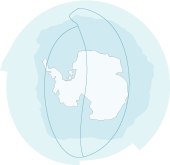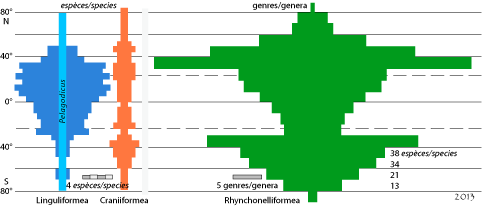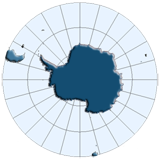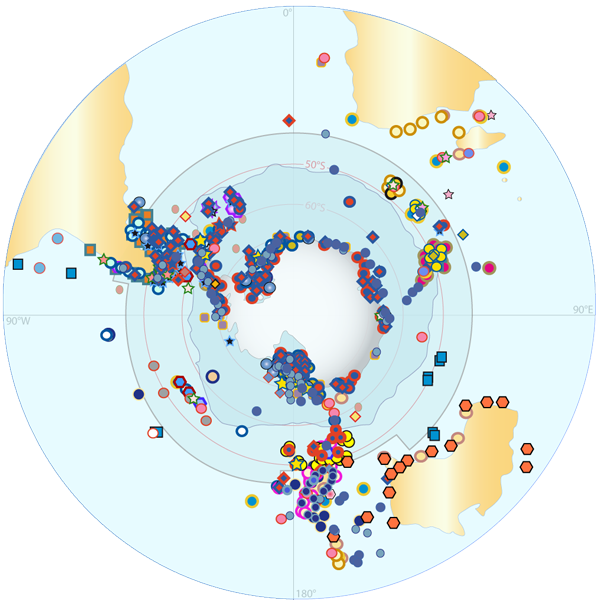ANTARCTICA
BRACHIOPODA

Online
since February 19, 2010
updated on March 20, 2025
![]() Partners
Partners
![]()


Distribution of rhe Antarctic brachiopods [enlarge]

| List | Systematics |
| BrachNet | ![]()
Brachiopoda in the Antarctic Benthos [ Atlas ]by Christian C. Emig
This website should be cited as follows:
The former version of this website has been published on 17th August 2017 under the below reference - it is regularly updated: Emig C.C. (2017). Atlas of Antarctic and sub-Antarctic Brachiopoda. Carnets de Géologie, CG2017_B03, 93 p. - [in pdf] The extant brachiopod taxa are unusual in their relationship to science in that they are studied and described not only by zoologists but also and preponderantly by palaeontologists. Nevertheless most early studies from the Antarctic waters were by zoologists: Friedrich Blochmann (1858-1931), Louis Joubin (1861-1935), Paul Eichler, William Dall (1845-1927), Johann Gerhard Helmcke (1908-), Paul Fischer (1835-1893) who had been sent material garnered during Antarctic cruises. However palaeontologists too: Thomas Davidson (1817-1885), Œhlert (1849-1920), Allan Thomson (1881-1928), Wilfrid Jackson (1880-1978), Merrill Foster (publications in 1974 & 1989) have studied extant Antarctic brachiopods, providing excellent descriptions of the morphology and anatomy of soft body parts. Palaeontologists who since the 1950’s have described some of the Antarctic brachiopods include only those characteristics found in fossils. Consequently, their accounts are restricted to characters used in describing fossils so the taxonomic characteristics they include are much less complete than the diagnoses prescribed by the International Code of Zoological Nomenclature (ICZN). This failing increased the number of species while omitting well-defined characters proposed previously. New species were established mainly on dimensional and morphological aspects of the shell, so several are invalid taxonomically. From the 70-75 species described in Antarctic and subAntarctic waters,
The identification of the species living in Antarctica and their geographical distribution, which commonly depasses this polar region, invites comment about the systematics of the brachiopods.
A. The successive versions of the ICZN were obviously never applied to brachiopod systematics by palaeontologists. So, as mentioned above, their diagnoses of Antarctic species did not follow the recommendations of the ICZN (2000 http://www.iczn.org/iczn/index.jsp for species, genus or family:
Various examples of diagnoses of Antarctic species considered as valid:
In Brachiopoda systematics these examples are not anecdotal for they are found in recent publications. Such diagnoses do not follow ICZN rules and thus support “splitting”. This practice also occurs at the genus level. Currently one can read “Diagnosis of genus as for species”. That too is against the rules of the ICZN, because to differentiate genera the generic characteristics must be stated. They cannot be the same as those defining a species.
Consequently, a large number of described species, not only those from the Antarctic area, lack phylogenetic authenticity. For example, Liothyrella moseleyi, L. delsolari and L. winteri could be considered synonyms of L. uva, along with Acrobrochus and Liothyrella.
B. However, morpho-anatomical characters were brought to prominence by various authors: musculature (Bulmann, 1939; Helmcke, 1939; Foster, 1974; Richardson, 1976), lophophore and disposition of mantle canals (Emig, 1992; Williams et al., 1997), pedicle (Richardson, 1976, 1979), and the taxonomic value of nephridia, gonads and larvae was not yet appreciated. None of these diagnostic characters was used in the revision of systematics in part H (Brachiopoda) of the Treatise of Invertebrate Paleontology (Vol. 2-6), although they are detailed in the Anatomy chapter of Volume 1 (Williams et al., 1997). 
Moreover, ignorance regarding ecological data makes it impossible to place a population in its biocenosis. And some of these data may also be considered as having a phylogenetic significance. It is well known that two species of the same genus may not occur in the same biotope. This fact must be taken into account in the Antarctic where specific diversity is low. Finally, there is a basic need to establish the intra- and inter-population variations for all taxonomic characters, as well as for those that are modified in accordance with the age of the individual. Three or more species of one genus have sometimes been established and described on the basis of differences in a given character, especially those of shell outline and shape. Yet such elements are known to have no taxonomic value. Consequently there is a pre-eminent need for the establishment of well-defined phylogenetic criteria for each species and genus that will result in a rigorous and reliable systematics, a requirement for any worthwhile analysis of biodiversity and molecular studies. A cladistic approach based on extant brachiopod species cannot be confined solely to the shape and dimensions of the shell.
C. The diversity of brachiopods in the Arctic and Antarctic realms is best expressed by their numbers, respectively 10 and 50 species. Obviously the epifauna is more heterogeneous and predominates in the Antarctic communities. List of brachiopod genera and species in the Arctic (Arndt & Grieg, 1933; Zezina, 1977, 1980, 1997)
Already in 1892, Fischer and Œhlert wrote: « Il sera donc nécessaire désormais de pratiquer une révision nouvelle des Brachiopodes et de supprimer peut-être un certain nombre d’espèces. Il en résulte que plus on étudie ces animaux, plus aussi diminue le chiffre des formes spécifiques légitimes. » [“At present it will be necessary to do a new revision of the Brachiopods and to perhaps remove a certain number of species. The consequence is that more these animals are studied, more also decreases the number of the valid taxa.”]
The correct identification of Brachiopoda is fundamental not only for the assessment of biodiversity, but also in the food and pharmaceutical industries, molecular biology, taphonomy, palaeoecological interpretation, and in the broad field of formal and informal education at all levels. In the last decades, several important advances have taken place in the way based on new morpho-anatomical taxonomic characters applying also to fossil taxa. Consequently, large revision of the brachiopod genera to ascertain the valid species based on new diagnosis is basically needed, at least in extant taxa.
Nota: the citations are available in the page REFERENCES. Best thanks to my friend Nestor Sander Rotsen for English improvement | |||||||||||||||||||||||||||||||||||||||||||||||||||||||||||||||||||||||||||||||||||||||||||||||||||||||||||||||||||||
Site online since February 19, 2009 - regularly updated
on REDIRIS
© from 2009 - by CdM Créations
Optimized for Safari, Chrome and Firefox (screen mini. 1152 x 864) ![]()





